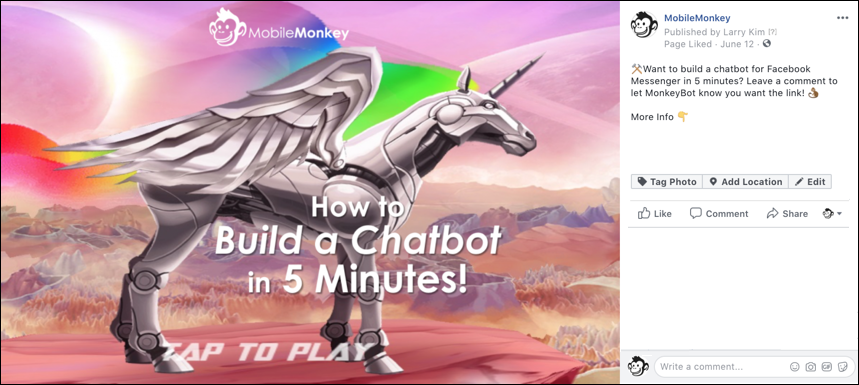Chatbots are making waves largely because chat and text is the preferred communication method for Millennials and Gen Z.
Businesses are using chatbots to provide instant customer service, product recommendation guidance, and for advertising and marketing.
Chatbots have emerged as a top-of-funnel tool for lead generation in both high-performing paid and organic campaigns.
If you’re a social media manager, Facebook Page admin, or digital marketer who wants to zero in on the organic traffic opportunity of chatbots, here are five ways to send more organic traffic to your site with chatbots.
1. Direct Organic Traffic with a Facebook Comment Guard Chatbot
Wouldn’t you love to turn your Facebook engagers into traffic on your site, or better yet, a lead?
With a Facebook post autoresponder chatbot, you can send an automatic response to someone who comments on your Facebook post.
If you’re strategic, you can funnel these engaged commenters as traffic to your website.
Plus, anyone who interacts with your chatbot becomes a Messenger contact that you can send follow-up messaging to.
A comment guard takes what you’re already doing on Facebook and turns it into a conversational interaction — more engaging than a static post in the News Feed.
See how this Facebook post autoresponder sends traffic to a website.

2. Drive Organic Traffic with a Chat Blast
Most businesses use email marketing to drive website traffic, that’s a given.
You can design a similar experience with a chatbot with 3x or better open rate in chat compared to email.
Schedule and bulk-send custom, interactive, and engaging chat blast campaigns that send engaged traffic to your site.
Just as email marketing platforms allow for list segmentation, Facebook Messenger marketing platforms like MobileMonkey (disclosure: I work for the company) allows for advanced contact segmentation.
Send specific messages – like a newly published guide, white paper or webinar invitation – with a link to your site to audience segments by defining unique attributes.
Recipients will receive a relevant message according to their interests, preferences, demographics, or any other category you define.
Doing a Facebook Messenger chat blast is free if you follow certain guidelines.
3. Invite Engaged Traffic via Chatbot Drip Campaign
Wouldn’t it be great to set up an automated sequence of messages that send members of your audience relevant links to a funnel on your website?
You can with Facebook Messenger drip campaigns.
With a drip campaign chatbot, you keep leads engaged and active over a period time, an approach that can be ideal for selling complex solutions, training leads, and onboarding.
Here’s an example use case:
Automate four or five messages to send to new contacts, each pointing to a link on your website with more information.
You have the ability to nurture audience segments in different ways, ensuring each group gets the unique form of attention they need to stay engaged and propel them through the pipeline.
4. Push Organic Traffic to Your Blog via RSS-Powered Chatbot Blast
When you publish new blog content, an RSS feed automatically updates.
That feed can be integrated into your Facebook Messenger chatbot, which will automatically send it to your subscribers.
RSS-powered chat blasting lets your audience subscribe to your blog and get notifications in Messenger.
Because open and click-through rates are higher in chat than email and other digital channels, an automated blasting feed for new blog content is an obvious win for sending your website traffic.
The Messenger mobile app sends users push notifications.
That means your readers receive a friendly and highly visible alert when new content arrives, increasing the odds that they will see what you have to say.
5. Forward Organic Traffic from Chatbot Link to Messenger
When you’ve integrated chatbots as a communication layer in your marketing mix, you’ll notice a few awesome things:
- You can send follow-up messaging to anyone who messages your bot.
- You can create automated sequences that qualify leads and activate customers.
- You can forward people from your interactions in chat to anywhere you like in your conversion funnel.
So as you’re designing your chatbot funnels, you’ll find you’ll want to link people directly to a strategically designed chatbot experience.
For example, you might want to link people to an engaging chatbot that signs them up for a virtual event,
Or you might want to link people to the chatbot that provides research or a resource.
A Messenger chatbot provides an awesome user experience because it’s dynamic and interactive, personalized and engaging, and always mobile-friendly.
Using a chatbot, you can drop a link to your website where a conversion can be completed, be it a sign-up, subscription, or purchase.
Because you can automate each of the tactics described here, build them once and let your bot do the heavy lifting for you.
More Resources:
Image Credits
All screenshots taken by author, November 2018
Subscribe to SEJ
Get our daily newsletter from SEJ’s Founder Loren Baker about the latest news in the industry!